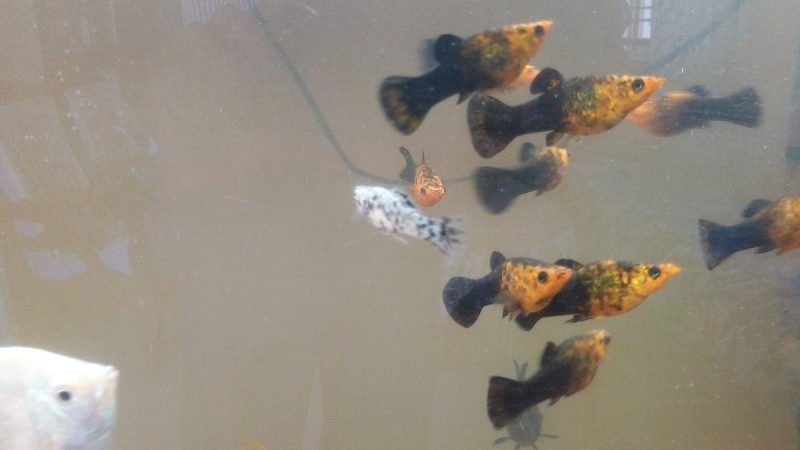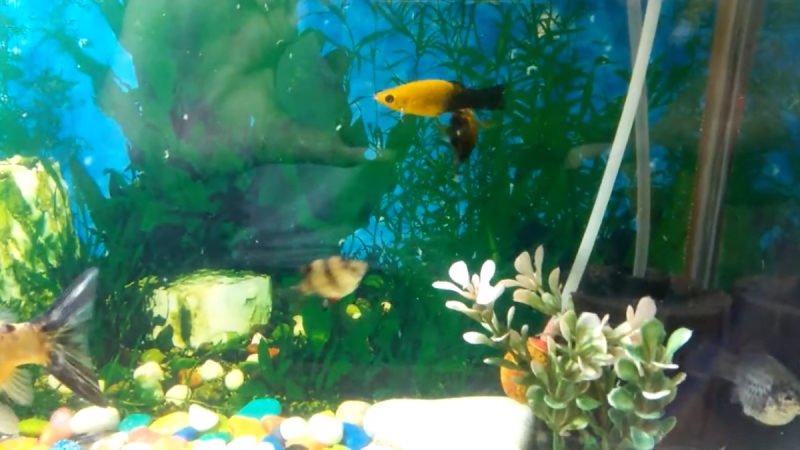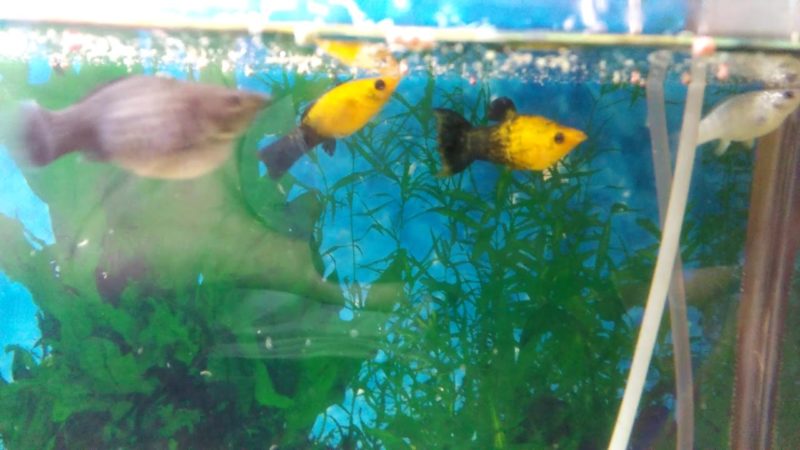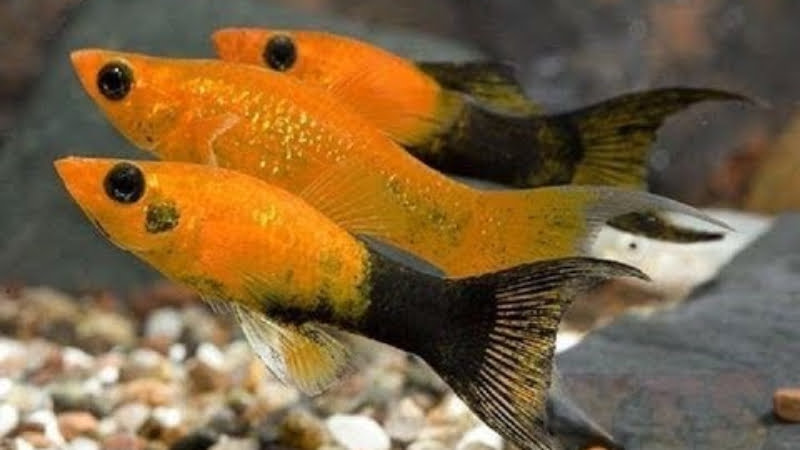The molly fish is a freshwater fish that comes from the Poecilia genus in the Poeciliidae family. Nowadays, Molly fish are commonly found in home aquariums because they are very easy to care for and can be found in several species. Mollies come in a range of colors, including black, white, silver, red, and orange. But have you ever seen chocolate molly fish?
That’s not a popular color of fish. That’s why you may not find much information about chocolate molly fish on the internet. However, this post will provide you with some useful information about that fish.
Related Articles
- Platinum Molly Fish Profile: Care, Food, Breeding, Tank And More!
- Black Molly Fish Male And Female: How To Determine & Important Notices
- Blue Molly Fish: A Rare Hue, 3 Detail Cases & Care Guidelines
- Orange And Black Molly Fish: Gender, Care, Diet, And Tank Condition
- Orange Molly Fish: Why It Is A Top Selection Includes An Unique Case
- Molly Fish White – The Perfect Fish For Every Aquarium
What Is Poecilia Sphenops?
Chocolate molly fish is one of the fancy strains of the mollies that come from the genus Poecilia Sphenops.
The Poecilia Sphenops fish is one of the types in the Poecilia genus that are commonly known as molly. As a way of distinguishing it from its congeners, it is sometimes known as the short-finned molly or as the common molly.
Those species inhabit freshwater streams and coastal brackish and marine waters along the Mexico coast.
The fish that live in the wild are dull and silvery in color. It is quite possible for the molly to produce fertile hybrids with a variety of Poecilia species, but most importantly, with a sailfin molly. The males of these species, in general, are quite aggressive in nature. Mollies appear to be a species that is highly adaptable and hardy.
Chocolate Molly Fish Facts & Overview:

- Care Level: Easy
- Temperament: Peaceful
- Color Form: Various
- Lifespan: Up to 5 years
- Size: Up to 4.5 inches
- Diet: Omnivores
- family: Poeciliidae
- Genus: Poecilia sphenops
- Minimum Tank Size: 10 gallons
- Tank Set-Up: Freshwater, planted tank
- Compatibility: Peaceful community aquarium
- Temperature: 72–78°F (22–25.5°C)
- pH: 7.5–8.5
- Hardness: 15–30 dGH
Chocolate Molly Fish Care
Like other molly fish, chocolate molly fish don’t require a lot of effort to raise and care for to keep them healthy. It makes them a great choice for anyone who is considering getting started with aquariums.
The best thing you can do for your mollies is to follow the established care guidelines provided by us here!
Tank Size
Mollies can do quite well in small and medium-sized aquariums due to their small size. In fact, most molly fish can live happily in a tank with a capacity as small as 10 gallons.
There’s no problem with the recommended tank size if you have four mollies, but if you have extra space, it’s always a good idea to go with a bigger tank. In order to keep a larger group, it is advisable to increase the tank size by at least three gallons per fish.
Water Parameters
Mollies can have quite a wide range of habitats in the wild. They are a type of freshwater fish that has a wide range of natural distribution. Although most of these species are found in rivers, some can also be found in brackish and even open ocean waters for short periods.
In general, mollies can adapt to a wide variety of environments. Typically, they prefer warm water, neutral pH, and hard water. Some people hold the belief that you can keep fish healthy by adding salt to the water, but this is not true. Fish can live perfectly well in freshwater environments all their lives, and in fact, they prefer it.
In terms of water parameters, you will need to adjust them depending on the species of molly you get, but here are some good baselines that will work well for the majority of them.
- Water temperature: 72°F to 78°F (some species go up to 80°F)
- pH level: 7.5 to 8.5
- Water hardness: 20 to 30 KH
I recommend you buy a water test kit to measure the parameters accurately. You’ll be able to see the status of your tank at a glance and make adjustments if necessary, with the help of this tool.
What To Put Into The Tank

In their wild habitat, mollies live with plenty of plants. So you should mimic that condition by adding plants and a lot of places to hide. You should also add a substrate like sand or gravel to the bottom of your tank.
The substrate can serve as an anchor for adding several live plants (mollies use these plants as shelters). There is nothing wrong with providing both tall plants, such as Anubias, and shorter ones, such as the Java Fern. Whenever placing the plants, make sure they are positioned along the perimeter of the aquarium, so there is still a lot of open space where the fish can swim.
Finally, complete the décor with a few natural elements, such as rocks, caves, and driftwood. By adding these items, you can also provide a little shelter for your fish. You can also create an environment for your mollies to snack on some algae that grow there.
Lighting & Filtration
It is fine to use standard lighting. There is no specific lighting requirement for moles, but you do need a source of light to keep your plants healthy.
Having a strong filtration system is something you will need, as Mollies produce a great deal of waste. Be sure the filter you choose is powerful enough to withstand a lot of waste. Adding additional sponge filters both internally and externally is also a good idea.
Diet And Feeding
In the wild, molly fish eat algae or other small invertebrates. Then you can feed the same diet to your tank-kept mollies so that they will get all the essential nutrients from their diets.
Molly fish eat a huge variety of algae as part of their diet, so growing this type of food in your tank is a great way to provide your fish with a wide variety of food sources. You can feed your molly fish algae wafers if you do not have enough algae in the tank to feed all your fish. As for plant-based options for molly fish, spinach, lettuce, and zucchini are also good options.
It is highly recommended that you also add molly fish flakes and live or frozen fresh foods such as bloodworms and brine shrimp to the molly fish’s diet so that the molly fish can receive a variety of nutrients. The molly fish will get all the nutrients they need if you alternate between plant matter, fish flakes, and live foods.
To feed mollies, you should provide a pinch of food twice each day. It is important to not let mollies eat continuously for more than two minutes at a time, as this could cause the fish’s digestive system to become overwhelmed.
Tank Mates

Mollies are generally peaceful fish, but they are prone to aggression when crowded in overcrowded tanks or when housed together with aggressive tank mates. Therefore, you need to house molly fish in a community aquarium with friendly fish and allow them plenty of room to swim.
It is best to think about adding different fish to your aquarium only after prioritizing adding other mollies because mollies enjoy the company of other mollies.
If you intend to add other aquarium species to the tank, you can consider these great tank mates for your molly fish:
- Guppies
- Danios
- Gouramis
- Platys
- Angelfish
- Tetras
- Swordtails
- Some cichlids (dwarf cichlids, ram cichlids, keyhole cichlids)
- Snails
- Algae-eating crabs
- Shrimp
Video About Cute Chocolate Mollies
FAQs
What is the rarest molly fish?
It is said that the black molly fish is the rarest molly fish in the world and is being bred in Singapore on farms. Likewise, sailfin molly species, especially the Mexican sailfin moly or short-finned moly, are extremely rare. Breeding them in an aquarium is not easy either.
How many mollies should be kept together?
Ideally, three to four mollies should be kept in the same aquarium. As this species of fish is a shoaling species, they are more accustomed to living with fish of the same species than with fish of different species. In spite of the fact that you should keep more than one mollie together in a tank, you should not overcrowd the tank.
Do molly fish get big?
By the time they are fully grown, male molly fish typically grow to a size of 3 inches or 7 cm, whereas female molly fish can grow to a size of 4 inches or 10 cm when fully grown. A molly fish takes around 3 to 4 months to grow to its full size, and the size is dependent on the conditions in the water, their diets, and more.
Conclusion
Although chocolate molly fish are not as popular as other molly fish in other colors, they are incredibly beautiful fish. If you have it in your aquarium, it will be a unique addition.
Just like other molly fish, chocolate molly fish also need good care and a good diet. Follow my care guide to make sure your chocolate molly fish, or any other fish live healthy and longer.

Annette M. Chaney is an experienced marine biologist with over 20 years of experience as an aquarist and fishkeeper. She started her first aquarium at a young age, filling it with frogs and goldfish obtained from the ten-cent pet store.
Annette grew up caring for and breeding African Cichlids, which led to a hobby in high school that doubled as a profitable means. Attending Reed College gave her time to solidify herself as an accomplished aquarium caretaker with an eye for sales. After that, from 2009 – 2013, she studied at Roger Williams University – one of the most prestigious universities for Aquaculture and Aquarium in USA. She is the founder of AquariumCircle since 2010.
